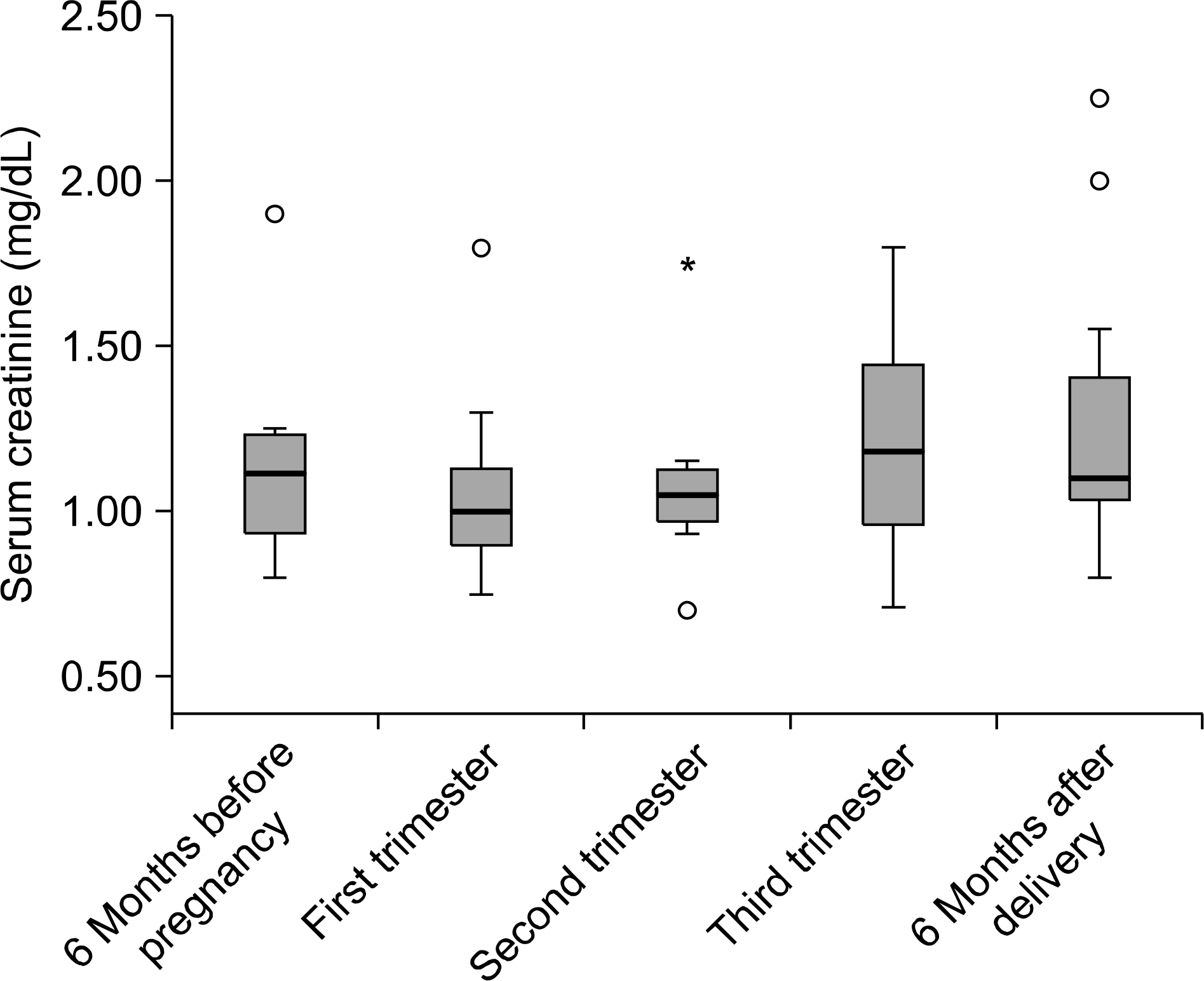Abstract
Background
The number of pregnancies in renal transplant recipients has increased. Many studies have shown that pregnancy increases the risk of graft, fetal, and maternal complications but does not affect the long-term outcome of the graft. We assessed the incidence and effect of pregnancy after renal transplantation and examined graft, fetal, and maternal outcomes.
Methods
Our study included 145 female recipients of childbearing age (15∼45 years) in our center from January 1990 to December 2011. The subjects were divided into two groups: pregnancy (n=17) and control (n=128). The 26 pregnancies in the 17 recipients were categorized as live births (n=10) or no-live births (n=16). These were analyzed for evaluation of pregnancy outcomes, graft function, and long-term graft survival.
Results
The pregnancy and control group had similar graft function and graft survival rates 5- and 10-year after renal transplantation. Outcomes of pregnancy were 10 live births, 8 therapeutic abortions, 7 spontaneous abortions, and 1 stillbirth. The mean serum creatinine levels of the pregnant recipients diminished during the first trimester (1.14±0.37 mg/dL) and increased slightly during the third trimester (1.18±0.37 mg/dL) to levels nearer the baseline (1.23±0.37 mg/dL). These ranges were stable. The mean time from transplantation to pregnancy was 20.73±3.57 months. Live birth rates were associated with the time from transplantation to pregnancy (71.78±37.75 months for live births and 19.38±12.71 months for no-live births, P=0.000). There were no significant differences in graft function, graft failure rates, and survival.
References
1). August P. Obstetric nephrology: pregnancy and the kidney: inextricably linked. Clin J Am Soc Nephrol. 2012; 7:2071–2.
2). Gill JS, Zalunardo N, Rose C, Tonelli M. The pregnancy rate and live birth rate in kidney transplant recipients. Am J Transplant. 2009; 9:1541–9.

3). Zachariah MS, Tornatore KM, Venuto RC. Kidney transplantation and pregnancy. Curr Opin Organ Transplant. 2009; 14:386–91.

4). Gorgulu N, Yelken B, Caliskan Y, Turkmen A, Sever MS. Does pregnancy increase graft loss in female renal allograft recipients? Clin Exp Nephrol. 2010; 14:244–7.

5). McKay DB, Josephson MA. Pregnancy after kidney transplantation. Clin J Am Soc Nephrol. 2008; 3(Suppl 2):S117–25.

6). Fontana I, Santori G, Fazio F, Valente U. The pregnancy rate and live birth rate after kidney transplantation: a singlecenter experience. Transplant Proc. 2012; 44:1910–1.

7). Oliveira LG, Sass N, Sato JL, Ozaki KS, Medina Pestana JO. Pregnancy after renal transplantation: a five-yr singlecenter experience. Clin Transplant. 2007; 21:301–4.
8). Sibanda N, Briggs JD, Davison JM, Johnson RJ, Rudge CJ. Pregnancy after organ transplantation: a report from the UK Transplant pregnancy registry. Transplantation. 2007; 83:1301–7.

9). Kim HW, Seok HJ, Kim TH, Han DJ, Yang WS, Park SK. The experience of pregnancy after renal transplantation: pregnancies even within postoperative 1 year may be tolerable. Transplantation. 2008; 85:1412–9.

10). Rahamimov R, Ben-Haroush A, Wittenberg C, Mor E, Lustig S, Gafter U, et al. Pregnancy in renal transplant recipients: longterm effect on patient and graft survival. A singlecenter experience. Transplantation. 2006; 81:660–4.

11). Nevis IF, Reitsma A, Dominic A, McDonald S, Thabane L, Akl EA, et al. Pregnancy outcomes in women with chronic kidney disease: a systematic review. Clin J Am Soc Nephrol. 2011; 6:2587–98.

12). Blume C, Sensoy A, Gross MM, Guenter HH, Haller H, Manns MP, et al. A comparison of the outcome of pregnancies after liver and kidney transplantation. Transplantation. 2013; 95:222–7.

13). Celik G, Toz H, Ertilav M, Asgar N, Ozkahya M, Basci A, et al. Biochemical parameters, renal function, and outcome of pregnancy in kidney transplant recipient. Transplant Proc. 2011; 43:2579–83.
14). Aivazoglou L, Sass N, Silva HT Jr., Sato JL, Medina-Pestana JO, De Oliveira LG. Pregnancy after renal transplantation: an evaluation of the graft function. Eur J Obstet Gynecol Reprod Biol. 2011; 155:129–31.

15). Richman K, Gohh R. Pregnancy after renal transplantation: a review of registry and singlecenter practices and outcomes. Nephrol Dial Transplant. 2012; 27:3428–34.

Fig. 1.
Changes in serum creatinine levels from 6 months before pregnancy to 6 months after delivery.

Table 1.
Clinical characteristics of pregnancies between live births and no live births
Table 2.
Clinical outcomes of the delivery in renal transplant recipients (n=10)
| Variable | Value |
|---|---|
| Gestational age (wk) | 37.2±3.1 (3∼41) |
| Infant birth weight (g) | 2,807.8±1,131.5 (1,130∼5,140) |
| APGAR score (min) | |
| 1 | 5.89±2.03 (2∼8) |
| 5 | 7.78±1.64 (4∼9) |
| Pregnancy outcome | |
| Preterm delivery | 1 (10/3.9 a) |
| Intrauterine growth | 3 (30/11.5 a) |
| retardation | |
| Low birth weight | 3 (30/11.5 a) |
| Anemia | 1 (10/3.9 a) |
| Data are presented as mean±SD (range) or number (%). | |
| Abbreviation: APGAR, Appearance, Pulse, Grimace, Activity, and Respiration. | |




 PDF
PDF ePub
ePub Citation
Citation Print
Print


 XML Download
XML Download